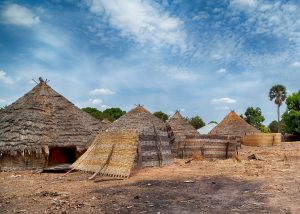How Biocultural Rights to Rooibos Opens the Way for Equitable Access and Benefit Sharing in Southern Africa
One of the many legacies of colonialism in Africa is the forced disconnect between people and their natural resources. This has opened the door for commercial exploitation of these resources by external interests without due regard to the original custodians and users of these resources.
Modern African countries therefore have an immense task at hand to remedy this situation, but the global community has not left them without the legal framework and tools to achieve this. In particular, the United Nations Convention on Biological Diversity’s Nagoya Protocol creates the framework for Access and Benefit Sharing (ABS) agreements that link the commercial exploitation of a genetic resource with those who hold the traditional knowledge associated with its use.
Biocultural Rights, Indigenous Peoples and Local Communities
In a recent chapter in the book Biocultural Rights, Indigenous Peoples and Local Communities – Protecting Culture and the Environment, Leslé Jansen and Rayna Sutherland of Resource Africa presented the case of indigenous people groups in South Africa using the Nagoya Protocol to win their rights to benefit from the commercial exploitation of rooibos.
The rooibos (translated red bush) plant is endemic to the Cederberg region in the Western Cape, South Africa. Today it is consumed around the world as a tea and is an important ingredient in many alternative remedy and cosmetic products. What is less well known is that the KhoiKhoi and San people have used this plant for very similar purposes since long before its discovery by the rest of the world.
Until finalising an ABS agreement in 2019, the traditional knowledge of these indigenous people was overlooked within South Africa and internationally. The chapter by Jansen and Sutherland, entitled The KhoiKhoi Community’s Biocultural Rights Journey with Rooibos shares the nine-year journey from a bioprospecting benefit sharing negotiations process through to a successful ABS industry-wide benefit sharing agreement.
The biopiracy campaign was levelled against commercial giant Nestlé in 2010 for attempting to patent the uses of rooibos and a similar plant called honeybush without the consent of the South African government or the KhoiKhoi and San people. Once the biopiracy was prevented, the legal option of an ABS agreement was chosen to create a fair deal between Nestle and later the South African rooibos industry and its traditional knowledge holders.
It was nonetheless necessary to prove that the KhoiKhoi and San were the rightful holders of this knowledge, and to create a mechanism through which they could channel the resulting benefits in an equitable manner. This was achieved by creating a Biocultural Community Protocol (BCP), which laid out how KhoiKhoi and San communities have related to the rooibos plant, which is key to clarifying their rights as traditional knowledge holders for the purpose of ABS. This is work Resource Africa SA’s CEO, Lesle Jansen, formed part of as one of their lawyers for the last 9 years before joining Resource Africa SA.
The process of developing a BCP created a sense of unity among communities that are now scattered widely in South Africa, including but not limited to those who live in the Cederberg Mountains where the rooibos plant grows naturally. This process was accompanied by the formation of representative bodies that would be entrusted with sharing the benefits derived from the ABS agreement in an equitable manner.
This journey was about more than rooibos, however, as these indigenous people groups have endured a long history of oppression in the colonial era and are still marginalised in modern day South Africa. For the KhoiKhoi, in particular, receiving recognition as indigenous people was key, as they had been forcibly labelled as “coloureds” by the apartheid administration and have ever since been perceived as somehow less than African. Yet this people group, which comprises several distinct sub-groups, has just as much claim to be called indigenous as San people. Jansen and Sutherland thus contextualise the rooibos rights case within the broader struggle of the KhoiKhoi and San people for recognition and restitution.
The success of the rooibos case has created a precedent for establishing ABS agreements around other valuable plant products that are associated with traditional African knowledge. These include products from the marula tree and buchu bush, both of which have a wide variety of commercial uses, making them similar to the rooibos case.
Resource Africa nonetheless advocates for expanding the horizons of ABS further, specifically to include the use of animal products. Traditional knowledge associated with animals includes the art of tracking, various uses for animal parts and knowledge associated with wildlife management. On lands where communities have won the rights to manage their wildlife as part of community-based natural resource management (CBNRM) programmes, they act as the custodians for resources that are used in the tourism and hunting industries.
The Nagoya Protocol: Access and Benefit Sharing
The knowledge and current stewardship of these high value resources should therefore be formally recognised through the national implementation of the Nagoya Protocol ABS framework. In a position paper and associated webinar on this topic, Resource Africa made the case that there is no reason why plant and animal resources should be managed separately.
Although the Nagoya Protocol has been used largely in relation to plants, the text of this framework does not prevent parties to CBD from including animals. Since African traditional natural resource management systems do not separate plants and animals, there is a strong case for African parties to CBD using the Nagoya protocol for both fauna and flora. Including the use of animal species in ABS agreements will further enhance the rights of communities engaged in CBNRM by giving them greater negotiating powers with external actors who seek commercially utilize plants and animals on communal lands.
Strengthening the rights of rural communities to manage and use their natural resources sustainably is one of Resource Africa’s main objectives. Consequently, while the rooibos case study is rightly heralded as a major victory, this is only the beginning of a much longer, broader journey for African communities to claim and exercise their rights.



